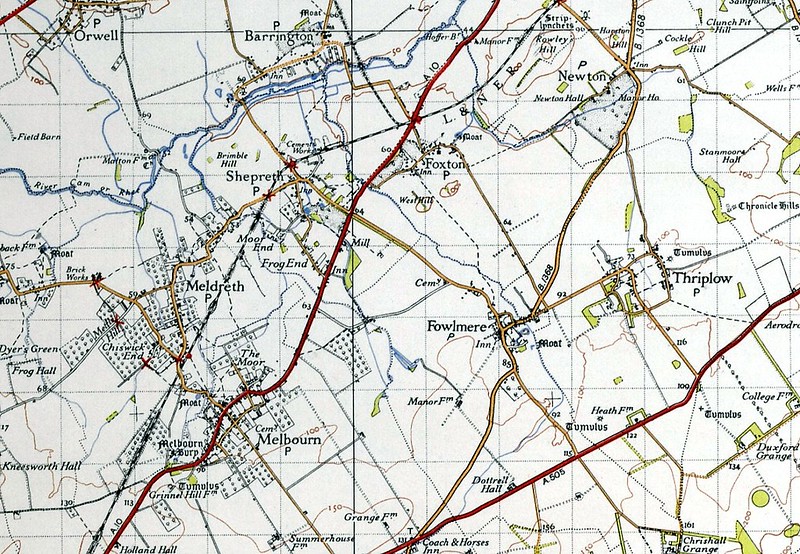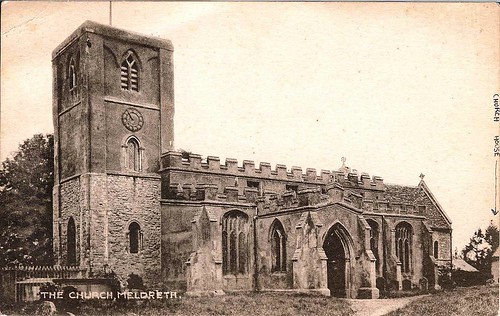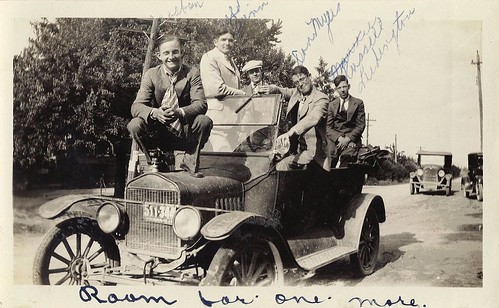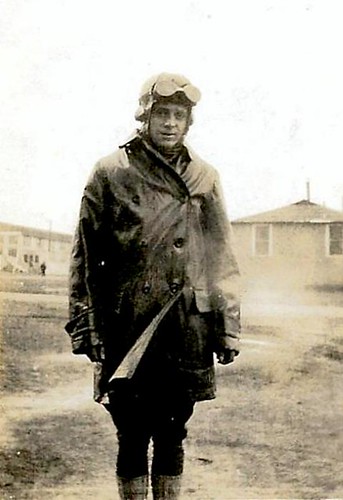The photo collage at the top of every blog page is composed of different images related to the Casbon journey.
Here are the stories behind the images.
Background: Map showing “Meldreth.”
 (Click on image to enlarge)
(Click on image to enlarge)
This is from a 1945 British Ordinance Survey map.[1]. The earliest I’ve been able to trace my ancestors is the 16th century in the parishes of Meldreth and Melbourn (just southeast of Meldreth on the map). Meldreth is about 9 miles southwest of the city of Cambridge, England.For the collage I changed the map from color to sepia tone.
Postcard of Holy Trinity Church, Meldreth, c.1900-1910.[2]

(Click on image to enlarge)
This is where the Meldreth Casbons were baptized, married, and buried. The parish records are one of the most valuable resources for finding information about our family. Many of these records are available online from sites like FamilySearch, Ancestry, and FindMyPast. They are also available on microfilm from the Family History Library in Salt Lake City, Utah.
Photo: “Room for one more”

(Click on image to enlarge)
Herbert A Casbon (1910-1989) is squatting on the hood of the car. Others labeled in the photo are (L to R) Ed Quinn, Dan Myers and Russell Ludington. The car looks like a Model T to me. Herb Casbon was the son of Amos Casbon (1869-1956) and grandson of James Casbon (abt 1814-1884), who emigrated to the United States in 1871. James’ descendants form one branch of the Casbons who came from Meldreth, England to Porter County, Indiana. The photo is undated; courtesy of Michael Casbon.
“Murder!”

(Click on image to enlarge)
This article from the 28 August 1884 Porter County Vidette describes the circumstances of James Casbon’s death. James was one of two brothers who left England and settled in Porter County, Indiana. Every indication suggests that James had a hard life, but that by coming to America, he gave his family opportunities they would not otherwise have had. I’ll talk more about James in a future post.
Christening record of Isaac Casbon, 1773

(Click on image to enlarge)
This is part of a page from the Bishop’s Transcripts for the Parish of Meldreth.[3] Ministers were required to make a copy of their parish records and send them to the Bishop every year…hence Bishop’s Transcript. The records were written with ink on parchment. If you look closely, you’ll see patterns on the parchment characteristic of animal hide. The top of this record says “An Account of Christenings Marriages and Burials from January the First 1773 to January the First 1774 taken from the Register of the Parish of Meldreth.” The last entry shown says “Isaac Son of Thomas and Jane Casbull – – – – – July 11.” Recall from the previous post that Casbull is a early variant of Casbon.
Isaac is important to the Casbon Journey because he is the common ancestor of most of the Casbons in the United States today. Two of Isaac’s sons, Thomas and James (see above) emigrated from England to the U.S. in the mid- to late 1800s. Both ended up in Porter County, Indiana. Isaac probably has living descendants in the United Kingdom from his other two sons William and Joseph (if you are one of those descendants and reading this, please provide a comment to this post!).
“Casbon Bros. Electric Co.” Advertisement, Portage High School Yearbook, 1949
The Casbon Brothers Electric Company was founded by brothers Loring (1896-1970) and Lynnet (1899-1983) Casbon in the early 1930s, and joined a short while later by their brother Leslie (1894-1990) in Valparaiso, Indiana. I have fond memories of wandering through the store in the 1960s, marveling at the latest technology such as transistor radios, and chatting with the repairmen. The three brothers were great grandsons of Thomas Casbon (1803-1888), the first of Isaac’s sons to emigrate to the United States (in 1846).
Photo: Leslie Casbon, 1918

(Click on image to enlarge)
Leslie Christy Casbon, mentioned in the previous paragraph, was my grandfather. He joined the U.S. Army Air Corps and completed flight training in 1918. He remained in the Army Reserves and was reactivated in World War II. Handwritten on the back of the photo: “me 1918 Wilbur Wright Field.”


Great work Jon, I appreciate your efforts, attention to detail and willingness to share!
LikeLike
Thanks Ron!
LikeLike
G’day. I am doing a One-Name Study on my surname and am planning on starting a blog shortly. I just wanted to say how impressed I am by your blog with the clean layout, nice casual, friendly, writing style and some of the items you have included (especially the collage and its breakdown and your diagram depicting your direct line). Great work !
LikeLike
Thank you Paul, that’s very kind. Please send me a link when you launch your blog.
LikeLike
[…] died August 22, 1884, from complications of an injury sustained in an unprovoked assault (See The Collage Explained). [17] His widow, Mary, was left with two step-children, Alice and Amos, ages 13 and 15, […]
LikeLike
[…] seen this record before, in “The Collage Explained.” From this record we know that Isaac was baptized July 11, 1773 and that his parents’ names […]
LikeLike
[…] “The Collage Explained” […]
LikeLike